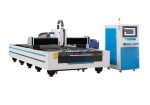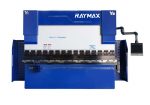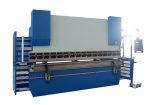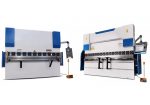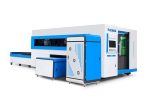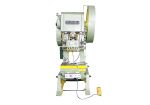Hydraulic sheet metal press brakes are an essential tool for optimizing production in the metalworking industry. This type of press brake uses a hydraulic system to bend and shape metal sheets with precision accuracy and repeatability. The hydraulic system allows for greater flexibility in the range of sizes that can be processed and offers superior performance compared to mechanical or pneumatic systems. The press brake is capable of forming complex parts with tight tolerances, making it an invaluable asset for producing high-quality parts in a wide range of sizes. With its ability to quickly and accurately produce parts, the hydraulic sheet metal press brake is an essential tool for streamlining production processes.
Optimizing Setup and Operation of a Hydraulic Sheet Metal Press Brake
Optimizing the setup and operation of a hydraulic sheet metal press brake is an important step to ensure efficient, precise production. This type of machine is a metalworking tool used to form sheet metal into various shapes, and it relies on hydraulic pressure to generate the force needed to bend and shape the metal. To optimize setup and operation of the press brake, it is important to understand the principles of the machine, including its components and functions.

The main components of a hydraulic sheet metal press brake include a bed, ram, and frame. The bed holds the metal in place while the ram is used to apply pressure. The frame houses the mechanical components, such as the motors and pumps, which are used to move the ram and control the flow of hydraulic fluid. The ram is connected to a cylinder containing pressurized hydraulic fluid. When pressure is applied to the cylinder, it pushes against a piston which in turn moves the ram and applies pressure to the metal.
When setting up a hydraulic sheet metal press brake, it is important to ensure that all components are properly aligned and that all necessary safety checks are performed. This includes inspecting all moving parts for signs of wear or damage, as well as ensuring that any lubricants or oils are filled or replaced as needed. Additionally, all fasteners should be checked for tightness and adjusted if necessary. Once all components have been checked and adjusted as needed, the machine can be powered up for testing.
During operation of a hydraulic sheet metal press brake, it is important to pay close attention to any changes in performance or sound coming from the machine. If there are any irregularities during operation, they should be addressed immediately before continuing production. Additionally, operators should be aware of any vibrations coming from the machine and adjust their work practices accordingly in order to avoid damaging any components or parts. Furthermore, operators should also be aware of any changes in temperature or pressure within the machine during use and take appropriate steps to reduce any potential risks associated with these changes.
In summary, optimizing setup and operation of a hydraulic sheet metal press brake is an important step in ensuring efficient and precise production. It is important to check all components for wear or damage before powering up for testing. During operation, operators should pay close attention to any changes in performance or sound coming from the machine as well as changes in temperature or pressure within the machine. By following these guidelines during setup and operation of a hydraulic sheet metal press brake, operators can ensure safe and efficient production at all times.
Ensuring Proper Maintenance of a Hydraulic Sheet Metal Press Brake
Ensuring proper maintenance of a hydraulic sheet metal press brake is essential to ensure that the machine is running safely and efficiently. It is important to inspect the press brake before each use, and to perform regular maintenance in order to keep it in good working condition.
The first step in maintaining a hydraulic sheet metal press brake is to inspect the machine for any signs of wear or damage. Pay particular attention to the hydraulic system, checking for any signs of leaks or wear. It is important to ensure that all hoses and seals are in good condition and that all connections are tight.

Once the machine has been inspected, it is important to lubricate the moving parts of the press brake, such as the slide rails, ram, and other moving parts. This should be done on a regular basis using a high-quality lubricant designed specifically for press brakes. Additionally, the oil level in the reservoir should be checked regularly and topped off if necessary.
It is also important to inspect the tooling used with the press brake on a regular basis. This includes checking for wear or damage on the punch and die sets as well as inspecting any other tooling used with the press brake. Any worn or damaged tooling should be replaced immediately as it can cause issues with accuracy or safety when using the press brake.
Finally, it is important to ensure that all safety features are functioning correctly on a regular basis. This includes checking for proper operation of safety switches, guarding, and any other safety features installed on the machine. Additionally, it is important to ensure that all operators are properly trained in safe operation of the machine and are aware of all safety protocols associated with its use.
By performing regular maintenance on a hydraulic sheet metal press brake, operators can ensure that their machine is running safely and efficiently while also ensuring accuracy and quality of workpieces produced.
Maximizing Efficiency and Productivity with a Hydraulic Sheet Metal Press Brake
A hydraulic sheet metal press brake is an essential tool for maximizing efficiency and productivity in sheet metal fabrication. It is used to bend sheet metal into complex shapes, such as those needed for automotive, aerospace, and other industrial applications. The hydraulic press brake works by using a hydraulic cylinder to apply pressure on the sheet metal. This pressure is exerted onto a die or punch which then bends the sheet metal into the desired shape.
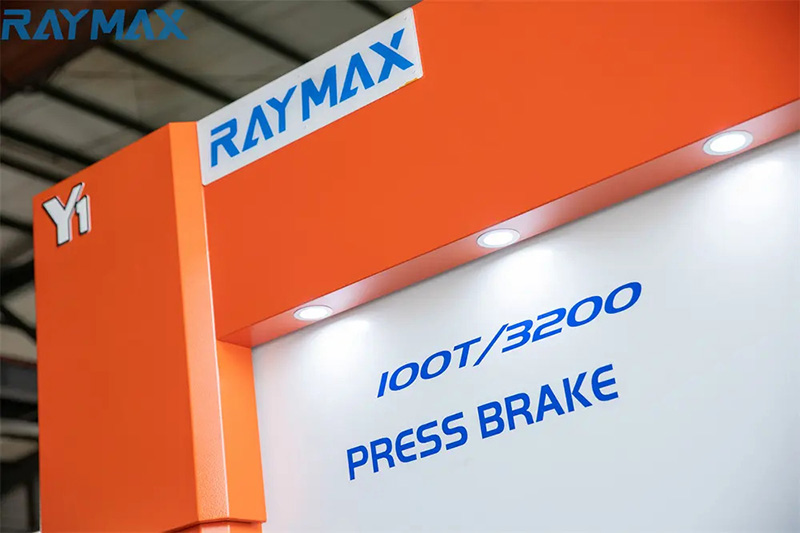
The main benefit of using a hydraulic sheet metal press brake is its ability to create complex shapes quickly and accurately. This is because the hydraulic cylinder can exert tremendous amounts of pressure with very little effort, allowing for precision bending of the sheet metal. In addition, the hydraulic system is designed to minimize energy consumption, resulting in higher productivity and cost savings.
The hydraulic press brake can also be used to form parts with tight tolerances, which is often required for more intricate designs. This accuracy is due to the fact that the pressure applied by the hydraulic cylinder can be precisely controlled, allowing for precise bending angles and shapes.
In addition to its accuracy and speed, the hydraulic press brake is also incredibly durable and reliable. Its components are designed to withstand extreme temperatures and pressures without breaking down or malfunctioning. This ensures that it can be used in production environments without fear of downtime or costly repairs.
Overall, the hydraulic sheet metal press brake is an invaluable tool for maximizing efficiency and productivity in sheet metal fabrication. Its accuracy, speed, durability, and reliability make it an ideal choice for any production environment that requires complex shapes with tight tolerances.
Utilizing Automation to Enhance Output from a Hydraulic Sheet Metal Press Brake
Utilizing automation to enhance output from a hydraulic sheet metal press brake is an increasingly popular and cost-effective method for improving production. Automation technology allows the press brake to be more precise and efficient, while also providing more flexibility in production. Automation can be used to reduce setup time and improve productivity, which leads to higher output and better quality parts.
Automation technology can be used to automate the process of loading and unloading materials into the press brake. Automated systems can detect when material is loaded and unload it into the press brake automatically. This reduces setup time and ensures that the material is correctly positioned for maximum efficiency. Automated systems also allow for more precise bending angles, which can lead to better quality parts.

Automation can also be used to control the pressure of the press brake. Automated systems can adjust the pressure settings of the press brake, allowing for greater precision and accuracy in production. This ensures that parts are bent correctly and accurately, resulting in higher quality parts. Automation also makes it easier to monitor the performance of the press brake, allowing for quick adjustments when needed.
Finally, automation can be used to automate post-press operations, such as trimming, deburring, and other finishing operations. Automated systems can quickly and accurately complete these tasks, resulting in a higher quality finish with less manual labor required. This helps reduce labor costs and increase productivity, leading to higher output from the press brake.
Overall, utilizing automation to enhance output from a hydraulic sheet metal press brake is an effective way to improve production efficiency and reduce costs associated with manual labor. Automated systems allow for greater precision and accuracy in production, as well as quicker setup times and fewer mistakes. This leads to higher quality parts with less manual labor required, resulting in improved output from the press brake.
Incorporating Quality Control Techniques for Hydraulic Sheet Metal Press Brakes
Incorporating quality control techniques for hydraulic sheet metal press brakes is essential for the production of high-quality parts. The hydraulic press brake is one of the most commonly used machine tools in metal fabrication, and its accuracy and repeatability are essential for producing accurate parts. Quality control measures should be taken throughout the production process, from setup and operation to the finished product.
The first step in quality control is to ensure that the press brake is set up properly. This includes making sure that the tooling is properly aligned and that the machine’s back gauge and ram stroke are properly set. It is also important to check that the hydraulic pressure is correct and that all of the safety features are functioning properly.
Once the machine is set up, operators should perform a visual inspection of the parts being produced to ensure that they meet the required specifications. This includes checking for burrs, sharp edges, cracks, deformities, and other defects. Any discrepancies should be immediately addressed.

The next step in quality control is to measure the parts using precision measuring instruments such as calipers, micrometers, and laser measurement systems. This allows operators to ensure that all dimensions are within tolerance and that any irregularities can be corrected before any further processing takes place.
The last step in quality control is to use statistical process control (SPC) methods to analyze data from each production run. This helps operators identify any trends in their processes and identify areas where improvement may be necessary. SPC can also be used to monitor production times and reduce cycle times, ensuring that parts are completed quickly without sacrificing quality.
Incorporating quality control techniques for hydraulic sheet metal press brakes is essential for producing high-quality parts with consistent accuracy and repeatability. By following these steps, operators can ensure that each part meets all required specifications while also optimizing production efficiency.
Utilizing Advanced Technology for Increased Precision in Hydraulic Sheet Metal Press Brakes
The utilization of advanced technology for increased precision in hydraulic sheet metal press brakes has revolutionized the sheet metal fabrication industry. With its precision and accuracy, the hydraulic sheet metal press brake is an invaluable tool for producing complex, high-quality parts with repeatable results.
Advanced technology in hydraulic sheet metal press brakes has improved the speed and accuracy of the bending process. The latest advances in machine vision systems, advanced sensors, and closed-loop servo systems allow for precise angle measurements and bend force control. This ensures that parts are consistently bent to the exact specifications required, even when working with materials that are difficult to form.
The increased precision and accuracy of hydraulic sheet metal press brakes is due to the incorporation of advanced technology such as CNC control systems, servo motors, and feedback loops. The CNC control system provides a precise level of control over the bending process, allowing for greater accuracy and repeatability. Servo motors are used to provide power to the hydraulic cylinders, allowing for more precise control over the speed and force of each bend. Feedback loops provide real-time feedback on the bending process, allowing for further refinement and adjustment of the parameters if necessary.
The use of advanced technology in hydraulic sheet metal press brakes also improves safety by preventing potential accidents caused by incorrect operation or misuse. Safety features such as automatic shutoff and emergency stop buttons help to prevent dangerous situations from occurring while also providing a layer of protection against incorrect operation or misuse.
The incorporation of advanced technology into hydraulic sheet metal press brakes has revolutionized the fabrication industry, allowing for more accurate, repeatable results with greater speed and efficiency than ever before. The improved precision and accuracy provided by these systems ensures that parts are bent to exact specifications every time, resulting in higher quality parts that meet all customer requirements.
Conclusion
The use of a hydraulic sheet metal press brake in a specific size is an effective way to optimize production. With the right set up and maintenance, the press brake can produce high quality parts with accuracy and repeatability. It is also an efficient tool that can save time and money in the long run. Hydraulic sheet metal press brakes offer a number of advantages over other methods of bending sheet metal, such as improved accuracy and repeatability, increased productivity, and cost savings. With its many benefits, it is no wonder why hydraulic press brakes have become a popular choice for optimizing production in many industries.

